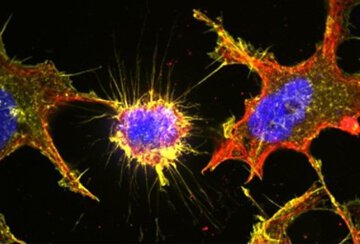Ievgenia Pastushenko, Federico Mauri, Yura Song,… Luis Ríos-Buceta, Pedro Jaén,…and Cédric Blanpain. FAT1 deletion promotes hybrid EMT state, tumour stemness and metastasis.
Nature. 2020
"The initiation of the metastasis dissemination process seems to have a common onset in different types of squamous cell carcinomas and to be linked to the loss of function of the FAT1 gene". - Dr. Luis Ríos Buceta -
Summary:
FAT1, which encodes a protocadherin, is one of the most frequently mutated genes in human cancers1-5. However, the role and the molecular mechanisms by which FAT1 mutations control tumour initiation and progression are poorly understood. Here, using mouse models of skin squamous cell carcinoma and lung tumours, we found that deletion of Fat1 accelerates tumour initiation and malignant progression and promotes a hybrid epithelial-to-mesenchymal transition (EMT) phenotype. We also found this hybrid EMT state in FAT1-mutated human squamous cell carcinomas. Skin squamous cell carcinomas in which Fat1 was deleted presented increased tumour stemness and spontaneous metastasis. We performed transcriptional and chromatin profiling combined with proteomic analyses and mechanistic studies, which revealed that loss of function of FAT1 activates a CAMK2-CD44-SRC axis that promotes YAP1 nuclear translocation and ZEB1 expression that stimulates the mesenchymal state. This loss of function also inactivates EZH2, promoting SOX2 expression, which sustains the epithelial state. Our comprehensive analysis identified drug resistance and vulnerabilities in FAT1-deficient tumours, which have important implications for cancer therapy. Our studies reveal that, in mouse and human squamous cell carcinoma, loss of function of FAT1 promotes tumour initiation, progression, invasiveness, stemness and metastasis through the induction of a hybrid EMT state.
1-5 PMID: 23354438, 27165741, 29849070, 32025007 and 24390350.
Why do you highlight this publication?
This publication demonstrates that alterations in FAT1 gene facilitate the spread of tumor cells in different types of epidermoid carcinomas of the skin, lungs carcinomas and head and neck carcinomas.
Publication commented by:
Dr. Luis Ríos Buceta
Dermatology Service of Hospital Universitario Ramón y Cajal
Head of the Dermatological Surgery Unit of Hospital Universitario Ramón y Cajal



